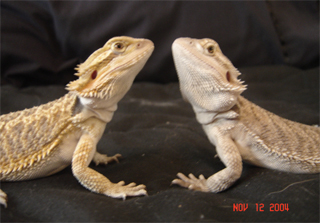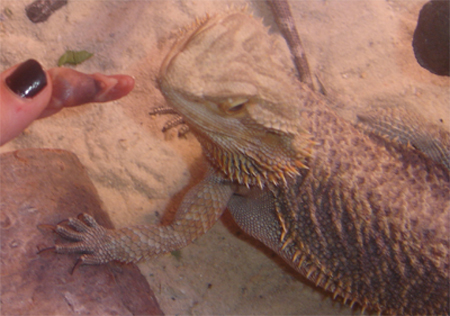Bearded Dragon Care

Pogona vitticeps
Bearded dragons are originally from Australia. They are found mostly in arid, rocky, semi-desert regions, but they are, also, found in arid open woodlands.
Bearded dragons are good climbers, sometimes seen on branches, bushes, and fence posts, but they are mostly terrestrial reptiles.
They are diurnal lizards, spending most of the day basking on rocks and in open areas. During the night and during the hottest parts of the day, they can be found in underground burrows.
Books About Bearded Dragons
Bearded Dragons as Pets
Bearded dragons are one of the best known 'beginner reptiles.' In general, they rarely bite their owners. But, should never be left to the hands of children. An adult should always help supervise handling and caretaking of the animal.
When they become angry, bearded dragons tend to "blow" up. They will flatten out and their beard will darken. This creates an illusion of a larger animal. When you see your bearded dragon do this, that means you should probably leave it alone. But, for the most part, they are very docile reptiles.
When handling a bearded dragon, try not to frighten it because it will bite, but if you handle it every day, it will become comfortable in your presence. You should pick up a Bearded Dragon very carefully, gently scooping it up your with your hand under its belly and behind its front legs. Be sure to keep your hand open so that the Dragon can step onto you with its back feet. Dragons do not grip as well as other lizards, so you should support them but do not hold on too firmly.
Remember to never pick up a bearded dragon by the tail. Their tails are very delicate and Dragons do not regenerate their tails as other lizards do.
Bearded Dragon Behavior
Bearded Dragon Lifespan
With proper care and husbandry, bearded dragons can live an average of 5 to 15 years.
Bearded Dragon Size
Bearded dragons are medium sized reptiles. They can reach up to 2 feet long to include the length of the tail.
Females tend to range about 16 to 20 inches long, whereas males tend to be slightly larger.
Bearded Dragon Enclosure Size
When housing one bearded dragon, a 40-70 gallon tank is recommended because they do like to run and climb. The tank should be both long and high; the optimum size should be around 65" long and 16" wide.
You may be able to get away with a smaller enclosure, such as a 40 gallon breeder, which is 36" long, 18" wide, and 18" tall.
You can buy some tanks at low prices, or you can be creative and design one of your own by using glass and/or wood.
Do not place young bearded dragons in enclosures that are too large. They can become stressed and feel lost. It is best to house baby dragons in 10- 20 gallon aquariums, and upgrade as they grow.
Do not purchase the screen aquariums to house bearded dragons, as they do not allow the proper temperatures. The airflow with a screen enclosure minimizes the temperatures.
Bearded Dragon Cage
Bearded Dragon Set Up
Filling the Enclosure
Substrate:
The enclosure should have some sort of substrate. Where many people disagree with loose substrate, playsand, paper substrates, potting soil (without perlite), and alfalfa pellets, can be used, but not recommended. If you choice to go with a loose substrate, Never use cedar. Regardless the type of substrate that you choose to use, daily cleaning is necessary to provide a healthy environment.
For smaller and younger Dragons, paper towels or turf should be used because they will try to eat sand and small rocks, which could lead to a trip to the vet. As dragons become six months and older, their eating habits become better, meaning they do not eat as many small rocks when hunting. This is the perfect time to switch substrates from paper to a turf substance. When changing to a turf substrate, sand is a better choice because when the dragon goes to the bathroom, its mess can be cleaned using a kitty litter scooper, and then thrown away.
Personally, I disagree with loose substrates, ESPECIALLY, calcium-based sands. I recommend using paper towels, reptile carpet, or a tile base such as slate.
The reason behind not using loose substrates is that, they can cause impaction when injested. Impaction can result in death.
Décor:
Bearded dragons are best kept separately. However, for multiple bearded dragons, you must increase the size of the aquarium, so that there is a proper number of shelter places and basking spots.
For shelter, you should have rocks, wood/ branches, and possibly plants.
Also recommended for the bearded dragon's tank, are plants. Although many dragon keepers say that fake plants are dangerous to bearded dragons because they may eat it, both real and fake plants can be safe it just depends on your dragon. If live plants are placed in the tank make sure that the soil does not contain perlite (the small white balls) because Dragons like eating them, although it makes them sick. Snake plants, small palms, and jade, are a few recommended live plants. You must make sure that the plants won't be eaten or ripped up very fast, and that they will be able to survive in the temperatures inside the tank.
In the wild, bearded dragons love to climb, so as a pet, they must be given items to climb on, such as driftwood. Drift wood can be expensive if bought at pet stores, and it can be infested with different types of bugs and mites. If you get your drift wood from outside, make sure that you cleanse it with bleach and water, so that when it goes into the tank, it is bug-free.
You can try reptile hammocks, but because bearded dragons become a little heavy weighted, they can weight the hammock down until the suction cups fall from the walls.
Reptile Outdoor Enclosure
Lighting
The lighting in a bearded dragon enclosure should include an incandescent spot light and a full-spectrum light. The ultraviolet light is very important to a bearded dragon's life as it provides the vitamin D3, and if a bearded dragon does not receive enough of vitamin D3, he may die (along with the lights, put a vitamin supplement in their food).
Using UV-B and UV-A bulbs has a positive physiological effect on the animal. It can stimulate activities, such as the appetite, activity level, general health, and they may play a role in the reproductive behaviors. Theses bulbs are a little costly, and must be replaced once every six months. Just like heating bulbs, they should be set on timer, about 8-10 hours daily.
* Remember: full-spectrum tubes should not be placed too close where the beardy can touch the tube, but at the same time the UV from the tubes only reach about 6-8". Have a perch or log that is near the top, but too close where the beardy can reach up and get burned.
Proper UV lighting is essential! It can help to prevent metabollic bone disease.
Heating
The daytime temperature for a bearded dragon should be between 75ºand 85ºF, with a basking site of 110º to 120º. The nighttime temperature should be between 60º and 75ºF. It is very important to make sure that basking temperatures are correct, as well as the overall enclosure temperatures. Proper heating is necessary for digestion.
The overall humidity should stay the same at 35%.
To get the correct temperature, you should use an incandescent bulb or spotlight, but do not use a regular light bulb. The bulb should be placed in a reflector type fixture, make sure that the fixture can handle the heat. Make sure to place the light fixture above the basking spot, located at one end of the tank.
The bulb wattage should create a temperature of 90º to 105º F in the section that is closest to the light. In a 25 gallon tank use a 30-40 watt bulb; in a 55 gallon tank, use a 60 watt bulb; in a 75 gallon tank use a 100 watt bulb. These are estimated wattages. You should NEVER estimate the temperature.
To measure the temperature, buy a digital thermometer. Again, NEVER estimate the temperatures within the enclosure. Temperatures that are both too low or too high can cause health problems. Too low temperatures can hinder digestion, an increase the risk of impaction.
Be sure to place the light and heat bulb fixtures on the screen top far enough away from the bearded dragon so that it will not get burned.
DONOT used heat pads or heat rocks INSIDE the tank because they may burn the bearded dragon!
Pinkie Mice for Bearded Dragons

Bearded Dragon Diet
Baby and juvenile bearded dragons should receive more feeder insects versus fruits and vegetables, but you should always provide fresh produce in the enclosure every day. This will help familiarize the bearded dragon with them. Slice the fruits and vegetables as fine, or small, as you can, making sure that it is size appropriate to the baby bearded dragon. Provide as many other feeder insects to the youngster that it will eat within a 15-20 minute period. Try to do this at least twice a day.
Adult bearded dragons should receive more fruits and vegetables than feeder insects. You should always provide fruits and vegetables. You can provide feeder insects twice a week.
Because bearded dragons are omnivorous, meaning they eat insects as well as fruits and vegetables, it is important to provide the proper nutrition!









